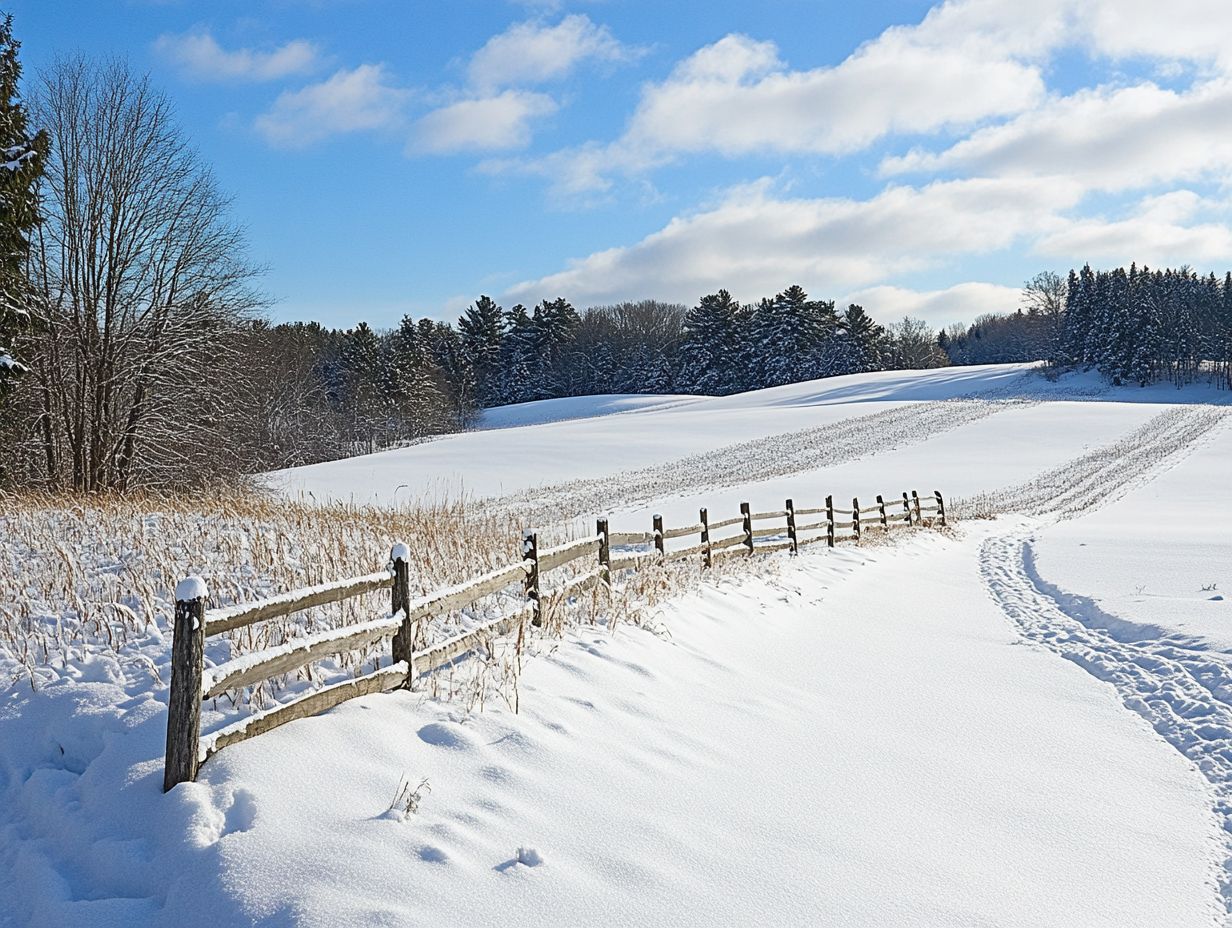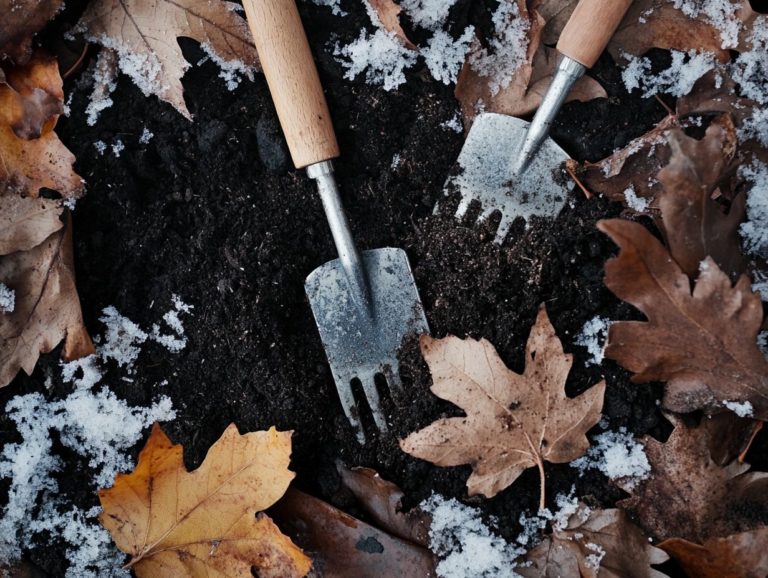Soil Conservation Techniques for Cold Climates
Soil conservation is paramount, particularly in cold climates where harsh conditions pose significant risks to soil health and agricultural productivity. Understanding the factors that affect soil in these regions is key to effective conservation.
This article explores exciting soil conservation techniques tailored for cold climates, shedding light on best practices, their benefits and limitations, as well as the challenges encountered in implementation.
You will also discover innovative approaches and technologies that are shaping the future of soil conservation. Engage with us as we unveil the essentials for safeguarding this vital resource.
Contents
- Key Takeaways:
- Understanding Soil Conservation in Cold Climates
- Common Soil Conservation Techniques
- Implementing Soil Conservation in Cold Regions
- Future of Soil Conservation in Cold Climates
- Frequently Asked Questions
- What are some common soil conservation techniques used in cold climates?
- How does mulching help with soil conservation in cold climates?
- What is crop rotation and how does it benefit soil conservation in cold climates?
- How does contour farming help with soil conservation in cold climates?
- What is cover cropping and how does it benefit soil conservation in cold climates, including the use of legumes like clover and alfalfa?
- Are there any specialized techniques for soil conservation in extremely cold climates, such as conservation tillage and no-till farming?
Key Takeaways:

- Proper understanding of soil health in cold climates is crucial for effective conservation.
- Implementing a combination of techniques, such as mulch application and crop rotation, can help mitigate the effects of cold weather on soil health.
- Innovative approaches and technologies, such as using cover crops and composting, can play a significant role in the future of soil conservation in cold climates.
Understanding Soil Conservation in Cold Climates
Soil conservation in cold climates is essential for preserving soil health and preventing erosion. This is especially important in areas that face severe winter conditions. Implementing effective soil management strategies not only mitigates the negative effects of soil damage but also enhances ecosystem balance something particularly crucial for agricultural producers in areas like Johnston County, North Carolina.
Utilizing techniques such as cover crops can dramatically improve soil structure. By adopting techniques such as cover crops, conservation tillage, and mulch application, you can greatly improve soil structure and boost biological activity, all while tackling the challenges brought on by climate change.
Factors Affecting Soil Health in Cold Regions
In cold regions, numerous factors significantly influence your soil health, impacting moisture retention, organic matter composition, and the essential nutrient profile for your crops. The interaction between soil types and environmental conditions can lead to soil damage if not managed effectively, often worsened by winter weeds that vie for vital nutrients.
Temperature fluctuations are key players here, as extreme cold can stifle microbial activity tiny organisms that help break down organic matter limiting nutrient availability and hindering organic matter breakdown. Moisture levels in these climates can swing dramatically; snowmelt offers crucial hydration during specific seasons, whereas frozen ground can restrict water movement during others. You must act now with effective nutrient management to tackle these challenges head-on.
With various soil types, from sandy to clay-rich, nutrient retention becomes a complex challenge, requiring you to implement careful nutrient management strategies. To ensure robust crop yields in these challenging environments, you must adapt your practices to enhance soil structure and fertility while minimizing the risks of degradation.
Common Soil Conservation Techniques
You ll find that farmers utilize a range of advanced soil conservation techniques to uphold soil health and combat erosion, especially in demanding climates. Among the most effective practices are:
- Cover crops like winter wheat and hairy vetch,
- Conservation tillage that minimizes soil disturbance,
- Strategic crop rotation to improve nutrient management and soil structure.
These approaches not only shield the soil from degradation but also positively impact wildlife conservation by enhancing habitat quality.
Best Practices for Cold Climates

Implementing best practices for soil conservation in cold climates is crucial for enhancing soil health and preventing erosion during harsh winters. Techniques like mulch application can significantly improve moisture retention and sediment control. Additionally, understanding soil drainage needs in cold climates is essential, as cover crops add valuable organic matter to the soil, boosting its structure and fertility.
Regular soil testing is equally important; it helps identify nutrient needs and adopt sustainable practices, such as using organic fertilizers and compost to strengthen soil health.
You can elevate these practices by integrating nutrient management strategies specifically tailored to your unique environmental conditions. No-till farming and streamside buffers can tackle challenges effectively, while mulches provide insulation and act as a barrier against sediment loss, reducing runoff during the spring thaw.
Seasonal soil tests empower you with vital data, allowing you to make informed decisions about soil amendments. Additionally, implementing streamside buffers or terracing can greatly reduce soil erosion and enhance water retention, fostering a resilient agricultural landscape.
Start these strategies today to keep your soils productive and sustainable, even in challenging cold weather scenarios.
Benefits and Limitations of Different Techniques
Understanding the benefits and limitations of various soil conservation techniques is essential for farmers aiming to maximize soil health while maintaining sustainable farming practices. Techniques like crop rotation and conservation tillage offer considerable advantages in erosion control and enhancing soil structure. However, they may also pose challenges in implementation and effectiveness depending on specific land use conditions.
Practices such as growing trees and crops together and cover cropping can significantly boost nutrient retention and support biodiversity, contributing positively to the overall ecological balance. You might find that these methods come with a steep learning curve and initial costs that could make you hesitant to adopt them.
Balancing these factors is crucial, as the long-term rewards of healthier soil can lead to improved crop yields and greater resilience against climate change. This ultimately benefits you as an agricultural producer and the local wildlife that depend on diverse habitats for survival.
Implementing Soil Conservation in Cold Regions
Challenges
Implementing soil conservation in cold regions presents unique challenges that demand careful attention to climatic and soil conditions for successful outcomes. You may encounter hurdles such as limited growing seasons and the pressing need for sustainable farming practices that foster ecosystem balance.
Strategies
No-till farming and the establishment of streamside buffers can effectively address these issues. Embracing these methods requires a commitment to continuous learning and adaptability, ensuring that your efforts yield long-term benefits for both your land and the environment.
Challenges and Solutions
You face numerous challenges regarding soil conservation, including soil erosion and the impacts of climate change. Identifying effective solutions demands innovative thinking and a commitment to practices that prevent erosion and enhance wildlife habitats.
In colder regions, specific hurdles include frozen ground and limited growing seasons. The tricky potential for thawing and refreezing cycles exacerbates these issues.
To combat soil degradation, consider adopting practices like cover cropping, which protects the soil during off-seasons, and contour farming, which minimizes water runoff. Utilizing organic mulches helps maintain moisture and prevent erosion, while growing trees and crops together can boost biodiversity and provide much-needed shade for your crops.
By integrating these innovative approaches, you can enhance soil conservation and contribute to a more resilient agricultural framework amidst ever-changing climatic conditions.
For more information on implementing these practices, consider reaching out to local agricultural extensions or conservation groups.
Future of Soil Conservation in Cold Climates

The future of soil conservation in cold climates is set for a remarkable transformation. Innovative approaches and new technologies will enhance sustainability.
As climate change increasingly reshapes agricultural practices, techniques like regenerative farming and soil testing kits are changing the game! They are essential in fostering soil health and delivering significant ecological benefits.
Embracing these advancements protects the environment and supports resilient farming practices for years to come.
Innovative Approaches and Technologies
Innovative approaches and technologies are essential in advancing soil conservation efforts, especially in cold climates where traditional methods may struggle.
Tools like soil testing kits have revolutionized nutrient management practices. Meanwhile, regenerative farming techniques help enhance carbon storage and improve soil health.
With technologies that use data and technology to manage farming think drones and satellite imagery you can monitor soil conditions with remarkable accuracy, giving you the power to make informed decisions about crop rotations and cover cropping.
These advancements tackle specific challenges such as soil erosion and nutrient depletion while promoting sustainable practices that preserve biodiversity. Integrating biochar and organic amendments into your soil management plans offers long-term benefits by enhancing soil structure, water retention, and overall fertility.
By embracing these innovative strategies, including sustainable farming practices, you re not just boosting productivity; you re also playing a pivotal role in contributing to a healthier ecosystem.
Frequently Asked Questions
What are some common soil conservation techniques used in cold climates?
Some common soil conservation techniques used in cold climates include mulching, crop rotation, contour farming, and techniques for soil aeration. These methods help protect the soil from erosion and maintain its nutrients.
How does mulching help with soil conservation in cold climates?

Mulching helps to regulate the temperature of the soil, keeping it warmer and preventing it from freezing. This allows for better water absorption and helps to prevent erosion caused by freezing and thawing cycles in the soil.
What is crop rotation and how does it benefit soil conservation in cold climates?
Crop rotation involves planting different crops in a specific sequence in the same field. This helps to improve soil health by replenishing nutrients and preventing the buildup of pests and diseases.
In cold climates, crop rotation can also protect the soil from erosion by alternating between deep-rooted and shallow-rooted crops.
How does contour farming help with soil conservation in cold climates?
Contour farming means planting crops along the land’s natural shape. This method slows down water flow, preventing topsoil from washing away.
In cold climates, contour farming is particularly effective in preventing erosion caused by melting snow and ice.
What is cover cropping and how does it benefit soil conservation in cold climates, including the use of legumes like clover and alfalfa?
Cover cropping involves planting specific crops to protect the soil and improve its health. These crops help prevent erosion by providing ground cover and improving soil structure.
In cold climates, cover crops also help to trap and retain heat, creating a more favorable environment for microorganisms to thrive and keep the soil healthy.
Are there any specialized techniques for soil conservation in extremely cold climates, such as conservation tillage and no-till farming?
Yes, there are specialized techniques such as snow fencing, which involves erecting barriers to prevent snow from drifting and causing soil erosion. Other techniques include windbreaks and shelterbelts, which involve planting trees or shrubs to act as a barrier against strong winds and prevent soil from blowing away.






